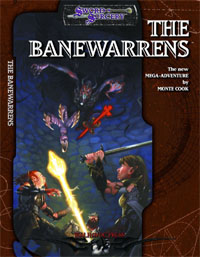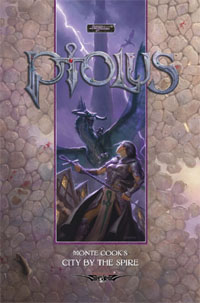 Starting tomorrow I’ll be posting campaign journals from my ongoing campaign — Ptolus: In the Shadow of the Spire. These journals are actually quite long, so I won’t be clogging up the main page with them. (EDIT: On the new website, I’ll be using “Read More” tags.)
Starting tomorrow I’ll be posting campaign journals from my ongoing campaign — Ptolus: In the Shadow of the Spire. These journals are actually quite long, so I won’t be clogging up the main page with them. (EDIT: On the new website, I’ll be using “Read More” tags.)
What I will be posting to the main page, however, are original essays relating to the journal entries. Some of these will be sort of “Behind the Scenes” commentary, which may only be of interest if you enjoy reading the journals themseles. (Which I hope you will.) But others will spin-off from the journal material to talk about my DMing techniques and adventure design. (Although, let’s be honest, whether those will be any more interesting or insightful is proably open to debate.)
This particular post will probably end up being a little bit of both, as I talk a little about the origins of the campaign.
STEP 1: THE SEED OF AN IDEA
I started my first full-fledged 3rd Edition campaign in the summer of 2001. The impetus for that campaign was the desire to run John Tynes’ Three Days to Kill. I spent a couple of weeks sketching out the map of a campaign world, roughing in the history and mythology of the setting, and then developing the broad outlines of a five act campaign (starting with the events of Three Days to Kill).
That was the origin of a setting I refer to as the Western Lands. Since that time, the Western Lands have served as the setting for most of my D&D games.
 My desire to run a Ptolus campaign actually dates all the way back to 2002. That was the year that Monte Cook released The Banewarrens mega-adventure. I knew as soon as I read The Banewarrens that this was a campaign I wanted to run — it combined an evocative mythology; a unique setting; and a flexible, open-ended design. I actually started laying down the groundwork immediately: The PCs in that first Western Lands campaign traveled through Ptolus, allowing me to establish both the city and the distinctive Spire.
My desire to run a Ptolus campaign actually dates all the way back to 2002. That was the year that Monte Cook released The Banewarrens mega-adventure. I knew as soon as I read The Banewarrens that this was a campaign I wanted to run — it combined an evocative mythology; a unique setting; and a flexible, open-ended design. I actually started laying down the groundwork immediately: The PCs in that first Western Lands campaign traveled through Ptolus, allowing me to establish both the city and the distinctive Spire.
One thing led to another, however, I ended up running several other campaigns before my attention returned once more to The Banewarrens. And then I hit one more delay because I heard that Monte Cook was developing the most ambitious city supplement ever published, describing the city of Ptolus in exuberant detail.
STEP 2: THE BACKBONE
By 2007, Monte Cook had published over 1000 pages of material for Ptolus (including the deluxe 660 page sourcebook). Improperly done, that much material could have acted as a straitjacket — choking any life or spontaneity from the setting. But, impressively, Cook designed the material to maximize its usefulness at the game table. The richness of the setting really excited me.
The other thing that excited me was the adventure material. In addition to The Banewarrens, I also had the sample adventures from the Ptolus sourcebook and the Night of Dissolution mega-adventure.
This material, with a fair degree of restructuring, became the backbone for the first two acts of a five-act campaign structure focused around a fusion of Ptolus mythology and the mythology of the Western Lands.
STEP 3: PUBLISHED ADVENTURES
 Opinions on using published adventures tend to vary quite a bit: Some people are for them as time-savers; others criticize them for lacking creativity.
Opinions on using published adventures tend to vary quite a bit: Some people are for them as time-savers; others criticize them for lacking creativity.
I tend to fall somewhere in the middle of this debate. For me, a well-designed adventure module is like a well-written play. Part of the entertainment value is in taking someone else’s creative material and interpreting it. There’s also something I really relish in the concept of a common experience shared disparately among many different gamers.
We tend to think of creativity as something that begins with a blank canvas and disparage anything that “rips off” something else. But the reality is that lots of valuable creative work doesn’t start with a blank canvas, and this type of creative interpretation is widely recognized in many artforms: Thousands of actors interpret the words of Shakespeare every year. T.H. White’s The Once and Future King, Sophocles’ Oedipus Rex, and elements of Neil Gaiman’s Sandman have all drawn from mythology. John Howe and Alan Lee interpret the works of J.R.R. Tolkien in their paintings.
On the flip-side, while I will strategically use published adventures in my campaigns, they seldom define my campaigns. For example, in the case of In the Shadow of the Spire, Monte Cook’s material forms the backbone of the first three acts of the campaign… but only about 25% of the adventure material I’m using is pre-published (and only some of the material is Cook’s).
(Although working in Ptolus has been interesting because so much of the original material I’m generating is still, quite naturally, being heavily influenced by the unique mythology and history of the city.)
Perhaps one of the reasons I have success with published modules is because my use is governed by desire instead of need. For example, I didn’t decide to run The Banewarrens because I was looking for a mini-campaign that would take the PCs from 6th to 10th level. I decided to run The Banewarrens because I thought it was a pretty awesome adventure.
And that’s pretty typical of how I use published adventures in general. On my shelf I’ve got a couple dozen or so published adventures for a variety of RPGs that I think are pretty nifty (for one reason or another). A few of those will serve as the impetus for an entire campaign that will grow up around them, like an oak growing out of an acorn. But most of them will see use for the opposite reason: I’ll be designing a campaign and I’ll see a place where I can slot them in.
For example, Act II of In the Spire of the Shadow revolves in part around pursuing a network of cults. It just makes sense to go out and grab a couple of the cult-oriented adventures I’ve got hanging around and seeing if I can make them work within the larger structure of this section of the campaign.
STEP 4: THE PLAYERS
In the Shadow of the Spire actually started as an online game. My primary motivation for this was David Blackmer. David had been one of my players in the original Western Lands campaign, and that campaign had actually come to an end when he moved to Indiana. David is an amazing roleplayer, and I had missed playing with him ever since he left.
So I put together a suite of tools including ScreenMonkey and Skype so that David and I could play together. When all was said and done, I’d also picked up players in Arizona and Iowa. Adding a couple of locals to the mix gave me a group with five players.
STEP 5: GETTING STARTED
Which is where we’ll pick up tomorrow…













Does this have a next section to read?
Link to the full set of posts and campaign journals.
I’ll have to see about trying to get these older posts set up with proper cross-links.